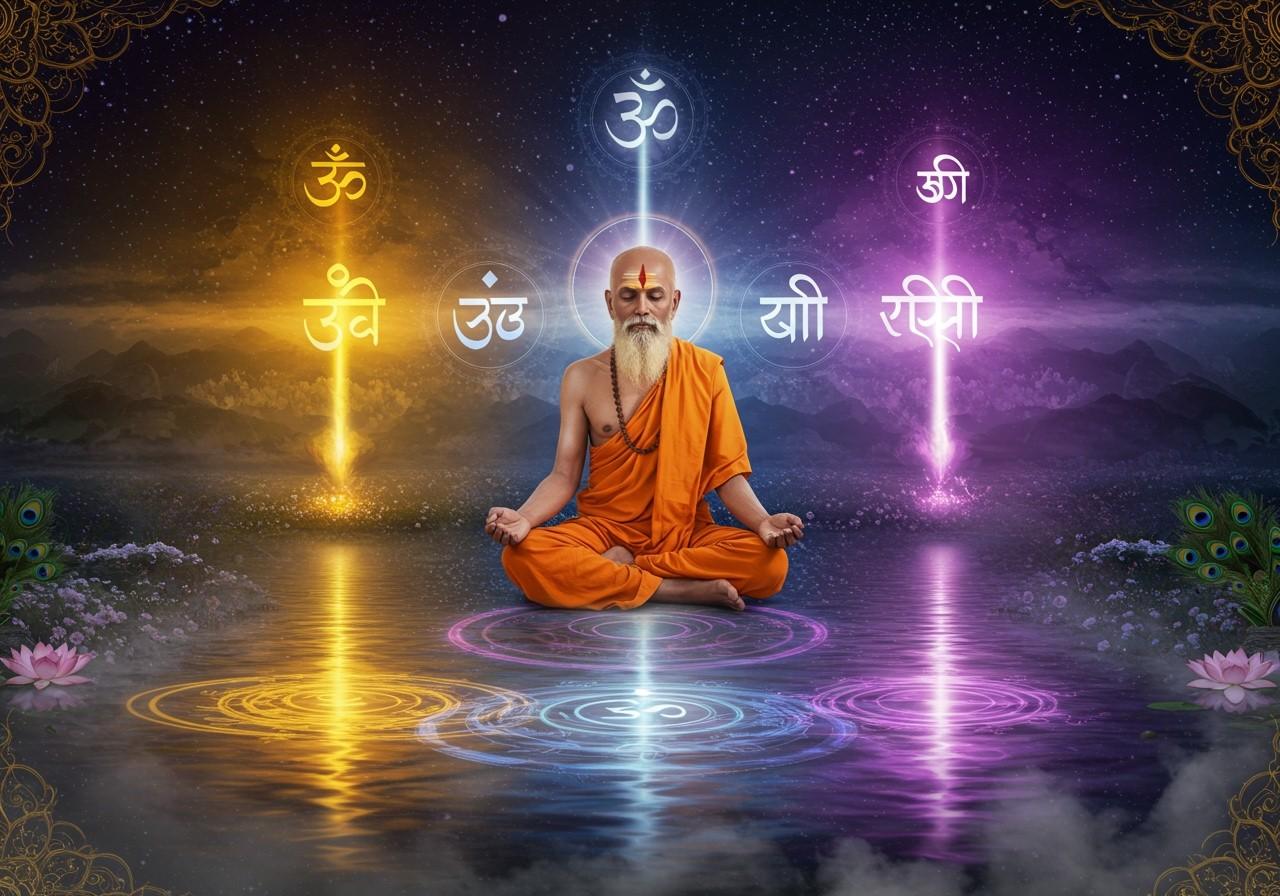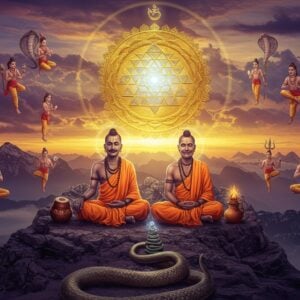
The Mandukya Upanishad, a concise text of twelve verses, offers profound insights into the nature of reality through the lens of the sacred syllable AUM. This Upanishad, along with Gaudapada’s Karika, a foundational text in Advaita Vedanta, serves as a cornerstone for understanding consciousness and the nature of existence. Gaudapada’s commentary elaborates on the Upanishad’s teachings, providing a systematic framework for grasping non-duality, the concept of illusion (Maya), and the ultimate reality of Brahman.
Decoding AUM and the Four States of Consciousness
The Mandukya Upanishad utilizes the symbol AUM to represent the entirety of existence. Its three components (A, U, M) correspond to three states of consciousness: waking (Vaishvanara), dreaming (Taijasa), and deep sleep (Prajna). The silence that follows AUM represents the fourth state, Turiya, the transcendental consciousness.
- Vaishvanara: The waking state, where the Self is conscious of the external world and interacts with gross objects. This is the experience of everyday life, full of sensory input and outward focus.
- Taijasa: The dream state, characterized by internal consciousness and subtle objects. In this state, the mind creates its own reality, drawing upon memories and impressions.
- Prajna: The deep sleep state, a unified state of consciousness filled with bliss. It serves as the doorway to the waking and dreaming states. The mind is withdrawn in this state, but not controlled. It is important to understand what distinguishes it from Turiya.
- Turiya: The fourth state, transcending waking, dreaming, and deep sleep. It is neither conscious of the inner nor outer world, nor is it a mass of consciousness. It is indescribable—a state of pure peace, bliss, and non-duality. This is the true Self, Atman.
Gaudapada’s Karika: An Illuminating Commentary
Gaudapada’s Karika is an essential commentary on the Mandukya Upanishad. It expands on the Upanishad’s core teachings, delving deeper into the concept of non-duality and the illusionary nature of the world. The Karika is divided into four chapters:
- Agama Prakarana (Chapter 1): This chapter utilizes Vedic scriptures to establish the principle of non-duality through the lens of AUM. It lays the foundation for understanding non-duality by relying on the authority of ancient texts.
- Vaitathya Prakarana (Chapter 2): Using reason and scripture, this chapter demonstrates the unreality of external objects of experience. It challenges our ordinary perception of the world, prompting us to question its true nature.
- Advaita Prakarana (Chapter 3): This chapter directly establishes non-duality through reasoned arguments and scriptural references. It culminates in the powerful assertion that nothing is ever truly born, challenging the concept of origination.
- Alatashanti Prakarana (Chapter 4): This chapter focuses on the cessation of suffering achieved through realizing non-duality. It explores how understanding the true nature of reality leads to liberation from suffering and the cycle of rebirth.
Key Insights from Gaudapada’s Karika
Gaudapada’s work highlights several key philosophical insights:
- Non-Duality (Advaita): The ultimate reality is non-dual, meaning there is only one undivided Self, Brahman. The appearance of multiplicity and difference arises from Maya, the illusion. This concept challenges our perceived separation from the divine.
- Unborn (Ajata): Gaudapada’s concept of Ajata asserts that nothing ever truly comes into existence. This challenges the conventional understanding of cause and effect and invites a deeper understanding of reality beyond the confines of time and space.
- Maya (Illusion): Our limited senses and ignorance lead us to believe in our individual, material forms. Maya is the veil that obscures our true nature, creating the illusion of separation from Brahman.
- The Mind: The mind, often distracted by desires, needs to be brought under control. Gaudapada also warns against inactivity, highlighting the importance of balance in seeking spiritual understanding.
- Liberation (Moksha): Realization of the non-dual Self leads to liberation from the cycle of birth and death (samsara). This is the ultimate goal of spiritual practice in Advaita Vedanta.
Gaudapada’s Karika provides a crucial framework for understanding the teachings of the Mandukya Upanishad. It emphasizes the importance of realizing the non-dual nature of reality as the path to liberation and true understanding. Explore related concepts in our articles on Hindu Philosophy and Sacred Hindu Symbols.
Deepen Your Understanding with Authentic Products from Poojn.in
Enhance your study of the Mandukya Upanishad and Gaudapada’s Karika with authentic products from Poojn.in. We offer a curated selection of items to support your spiritual journey:
- Srimad Bhagavad Gita (Bengali Version): Delve into this sacred text for further insights into Hindu philosophy and spiritual practice. This version provides access to the Gita in Bengali, allowing for deeper connection with its teachings.
- Lord Shiva Murti: Incorporate a sacred Murti into your meditation practice to deepen your connection with the divine. This beautiful Murti can serve as a focal point for contemplation and reverence.
- Raksha Sutra (Sacred Thread): Wear a Raksha Sutra as a symbol of protection and spiritual connection. This sacred thread serves as a reminder of your commitment to spiritual practice.
Explore our full collection at Poojn.in and enhance your spiritual journey.


